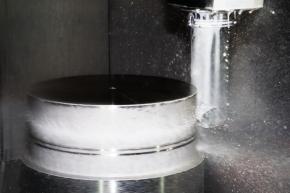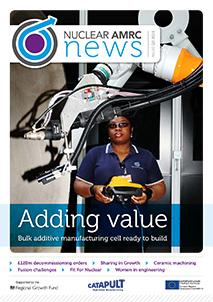Nuclear AMRC machining specialists are investigating the use of ceramic cutting tools with high-pressure coolant, a combination which could deliver significant improvements in production efficiency.
 Ceramic inserts are used in industries such as aerospace for their excellent wear resistance at high cutting speeds on hard-to-machine heat-resistant alloys. They are often used without any coolant, to maintain the localised heat required to cut alloys such as Inconel.
Ceramic inserts are used in industries such as aerospace for their excellent wear resistance at high cutting speeds on hard-to-machine heat-resistant alloys. They are often used without any coolant, to maintain the localised heat required to cut alloys such as Inconel.
Coolant can still bring benefits to ceramic machining by increasing tool life, but its delivery has to be carefully managed to avoid fracturing caused by thermal shock.
The Nuclear AMRC is working with tier one member Sandvik Coromant to test tooling which combines ceramic inserts with high-pressure coolant delivery, and to optimise cutting conditions for applications in the civil nuclear supply chain.
“Working in partnership with the Nuclear AMRC provides a perfect collaborative environment to identify, design, test and deliver a fully optimised component solution,” says Steve Weston, advanced machining application centre manager for Sandvik Coromant.
The project is focusing on Inconel, a nickel-based heat-resistant alloy widely used in reactor components and jet turbines.
“Inconel’s superior yield and tensile strength make it extremely difficult to machine effectively,” says Eva McLeod, project engineer at the Nuclear AMRC. “This research will expand our knowledge of new machining techniques, develop effective methods of machining difficult materials, and help us understand more about the benefits of using ceramic inserts such as improved surface quality and reduced machining time.”
Initial trials on the Nuclear AMRC’s Hermle C60 mill-turn centre have shown that the concept of combining ceramic inserts with high-pressure coolant is sound, delivering a significant increase in metal removal rate.
The ongoing project will aim to define optimal cutting conditions for a range of materials and applications, and to build a business case to show the cost and time advantages of the technique.
 For more news on how the Nuclear AMRC is supporting industry through manufacturing R&D and supplier development, download our Q3 newsletter (5MB pdf).
For more news on how the Nuclear AMRC is supporting industry through manufacturing R&D and supplier development, download our Q3 newsletter (5MB pdf).






